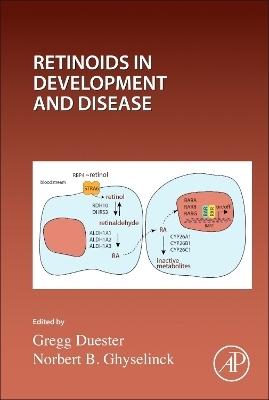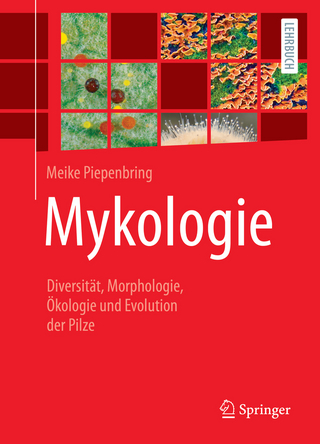
Retinoids in Development and Disease
Academic Press Inc (Verlag)
978-0-323-91700-1 (ISBN)
- Noch nicht erschienen (ca. März 2025)
- Versandkostenfrei innerhalb Deutschlands
- Auch auf Rechnung
- Verfügbarkeit in der Filiale vor Ort prüfen
- Artikel merken
Additional sections cover Retinoic acid homeostasis and disease, Redefining the roles of endogenously produced retinoic acid in heart development and regeneration: lessons from genetic models, The Multifaceted Roles of Retinoids in Vision, Eye Development, and Retinal Degenerative Diseases, Essential roles for retinoid signaling in craniofacial development, and much more.
The goal of my research is to understand the function of all-trans retinoic acid (ATRA) receptors (RARs) during development and in germ cell physiology. Early in my career I gained a background in reproductive biology with expertise in the area of nuclear receptor signaling. This inspired my research direction. As a postdoctoral fellow in the group of Pr Pierre CHAMBON, I generated and analyzed mutant mice lacking the beta isotype of RAR. Obtaining a permanent position of researcher at the French CNRS (Centre National de la Recherche Scientifique) in 1998, my research led to the characterization of a large panel of RAR-deprived mutant models, yielding the first evidence that (i) RXR/RAR heterodimers are transducers of the ATRA signal in vivo, (ii) specific heterodimers are required at many distinct stages during early embryogenesis and organogenesis, (iii) the physiological role of ATRA and its nuclear receptors cannot be extrapolated from teratogenesis studies using retinoids in excess. In 2001, I founded my own research team at Institut de Génétique et Biologie Moléculaire et Cellulaire (IGBMC), and expanded my research into the function of ATRA synthesizing enzymes during development. Later, by studying spatiotemporally loss-of-function genetic mouse models, I investigated the role of RARs in gametogenesis. As a PI on several ANR-funded grants, I showed that ATRA-activated RARs acting both in spermatogonia and in supporting, Sertoli, cells of the seminiferous epithelium are necessary to induce spermatogonia differentiation. I also provided genetic evidence that RARs (as well as ATRA-synthesizing enzymes) are fully dispensable for meiotic initiation in both oocytes and spermatocytes, disqualifying thereby ATRA act as the long-searched meiosis-inducing substance. I was an author on several reviews including a 2006 article in Annual Reviews in Pharmacology and Toxicology summarizing the function of RAR during mouse embryogenesis and organogenesis. In 2015 and 2017, my laboratory published two reviews in Biochimica et Biophysica Acta and in Current Topics in Developmental Biology summarizing the knowledge on the function of ATRA-activated RARs in germ cell differentiation gained by studying loss-of-function mouse models. In 2019, I published a Development at A Glance review on ATRA signaling in Development along with Pr. Duester who is a co-Editor in this volume of Current Topics in Developmental Biology. As Pr. Duester, my goal now is to bring knowledge of how ATRA normally functions to as wide an audience as possible. The goal of my research is to understand the function of retinoic acid (RA) during development. Early in my career I gained a broad background in developmental biology with expertise in the area of RA signaling that directed my research direction. As a postdoctoral fellow I cloned one of the first genes known to encode an enzyme for RA synthesis. As an Assistant Professor my research led to the discovery and characterization of one of the first RA response elements to be described. As a Professor at the Sanford Burnham Prebys (SBP) Medical Discovery Institute, I expanded my research into the function of RA by generating mouse knockouts of enzymes controlling RA synthesis. As a PI on several NIH-funded grants, I laid the groundwork for understanding RA function by providing genetic loss-of-function evidence implicating RA in major developmental pathways including eye development, body axis formation, somitogenesis, limb formation, and neurogenesis. I was an author on several reviews including a 2008 article in Cell summarizing what is known about embryonic RA synthesis and signaling, and a Cell SnapShot on Retinoic Acid Signaling in 2011. In 2015, my laboratory published a review in Nature Reviews Molecular Cell Biology summarizing the developmental pathways and genes directly controlled by RA during organogenesis. In 2017, I published a Letter in Science describing how challenges in the RA signaling field can be solved with more reliance on knockout studies which can now be performed more easily with CRISPR/Cas9 gene editing. In 2019, I published a Development at A Glance review on RA signaling in Development along with Dr. Ghyselinck who is a co-Editor in this volume of Current Topics in Development and Disease. My goal now is to bring knowledge of how RA normally functions to as wide an audience as possible.
Preface
Gregg Duester and Norbert Ghyselinck
1. Retinoids, Retinol-Binding Protein 2 (RBP2), Retinol-Binding Protein 4 (RBP4): Obesity and Metabolic Disease
William S. Blaner
2. Early Retinoic Acid Signaling Organizes the Body Axis and Defines Domains for the Forelimb and Eye
Gregg Duester
3. Rethinking Retinoic Acid Self-Regulation: A Signaling Robustness Network Approach
Abraham Fainsod and Rajanikanth Vadigepalli
4. Meiotic initiation in the fetal ovary without retinoic acid receptors: an unforeseen twist
Norbert Ghyselinck
5. Action of retinoic acid on progenitor cells in the testis
Michael David Griswold
6. Role of Cellular retinoic acid binding proteins (CRABPs) in regulating retinoic acid metabolism and signaling
Nina Isoherranen
7. Retinoic acid homeostasis and disease
Maureen A. Kane
8. Redefining the roles of endogenously produced retinoic acid in heart development and regeneration: lessons from genetic models
Alexander R. Moise
9. The Multifaceted Roles of Retinoids in Vision, Eye Development, and Retinal Degenerative Diseases
Krzysztof Palczewski
10. Essential roles for retinoid signaling in craniofacial development
Lisa L. Sandell
11. Retinoic acid signaling in pancreas development, islet function, and pancreatic diseases
Lori Sussel and David Lorberbaum
12. Vitamin A supply in the eye and establishment of the visual cycle
Johannes von Lintig
| Erscheint lt. Verlag | 1.3.2025 |
|---|---|
| Reihe/Serie | Current Topics in Developmental Biology |
| Verlagsort | Oxford |
| Sprache | englisch |
| Maße | 152 x 229 mm |
| Themenwelt | Naturwissenschaften ► Biologie ► Botanik |
| Naturwissenschaften ► Biologie ► Genetik / Molekularbiologie | |
| Naturwissenschaften ► Biologie ► Zellbiologie | |
| ISBN-10 | 0-323-91700-3 / 0323917003 |
| ISBN-13 | 978-0-323-91700-1 / 9780323917001 |
| Zustand | Neuware |
| Informationen gemäß Produktsicherheitsverordnung (GPSR) | |
| Haben Sie eine Frage zum Produkt? |
aus dem Bereich


